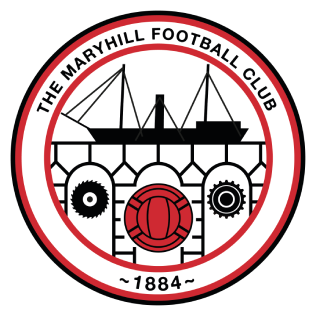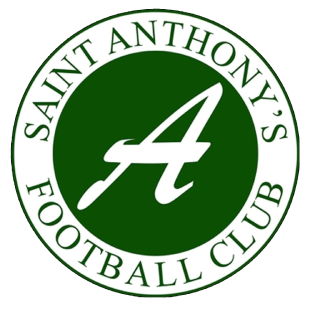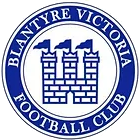
Hibernian Football Club, commonly known as Hibs, is a professional football club based in the Leith area of Edinburgh, Scotland. The club plays in the Scottish Premiership, the top tier of the Scottish Professional Football League (SPFL). The club was founded in 1875 by members of Edinburgh's Irish community, and named after the Roman word for Ireland. Nowadays, while the Irish heritage of Hibernian is still reflected in the name, colours and badge, support for the club is now based more on geography than ethnicity or religion. Their local rivals are Heart of Midlothian, with whom they contest the Edinburgh derby.

Larkhall Thistle Football Club is a football club from Larkhall, in South Lanarkshire, Scotland. Formed in 1878, "the Jags" are Scotland's oldest continuous Junior football club and currently compete in the West of Scotland League Third Division. The team plays in red and white stripes and its home ground since 1881 has been Gasworks Park.

Maryhill Football Club are an association football team based in the Maryhill area of Glasgow, Scotland. The team is a member of the Scottish Junior Football Association, now playing in the West of Scotland Football League Second Division in the 2022-23 season.

St Anthony's Football Club is a Scottish non-league football club based in Glasgow. Nicknamed the Ants, they play in green-and-white hooped kits and currently operate in the West of Scotland League Second Division.

Blantyre Victoria Football Club, also known as Blantyre Vics, are a Scottish association football club based in the town of Blantyre, South Lanarkshire. Formed in 1889, they play at KG Stadium. They currently compete in the West of Scotland Football League First Division in the seventh tier of the Scottish football league system. Historically, they shared a healthy rivalry with Blantyre Celtic who played nearby at Craighead Park, until Celtic were dissolved in 1992. The team have been managed since June 2016 by former Alloa and Stirling Albion midfielder John Gibson.

Wishaw Football Club is a Scottish football club based in the town of Wishaw, North Lanarkshire. The club currently competes in the West of Scotland League Second Division.
William Esplin Ormond was a Scottish football player and manager. As a player, Ormond was well known as one of Hibernian's Famous Five forward line, winning three league championships in the late 1940s and early 1950s. After a successful spell managing St Johnstone he led Scotland to the 1974 World Cup finals. Scotland were unbeaten at that World Cup, but were eliminated on goal difference.
Robert Lowe McPhail was a Scottish professional footballer, who played for Airdrieonians, Rangers and represented Scotland.
Gordon Smith was a Scottish footballer. He is the only player to have won a Scottish league championship with three clubs: Hibernian, Heart of Midlothian, and Dundee. Smith also represented Scotland and the Scottish League XI.
Robert Auld was a Scottish football player and manager. He was a member of Celtic's Lisbon Lions, who won the 1967 European Cup Final.

James McMenamin, was a Scottish footballer who most notably played for Celtic from 1902 to 1920 and later served as assistant manager in the 1930s. He has been described by the club as "a true Celtic legend".
The Scottish Junior Football League (SJL) was a Scottish football competition that, through various incarnations, existed from 1892 to 1947.
Joseph Montgomery Harper is a Scottish former footballer, mainly remembered for his two spells with Aberdeen, during which he won the three main domestic trophies once each and became the club's record goalscorer with 206 goals in major competitions. He also played for Morton and Hibernian in Scotland, and for Huddersfield Town and Everton in England. He finished his career in the Highland League.
Joseph McBride was a Scottish footballer who played for clubs including Celtic, Hibernian, Motherwell and Dunfermline Athletic. He was a prolific striker and has the third highest tally of goals in the Scottish league since football resumed after the Second World War. McBride also represented both Scotland and the Scottish League.
Hugh Shaw was a Scottish football player and manager, most notably with Hibernian.
Duntocher Hibernian Football Club were a Scottish Junior football club from the village of Duntocher, West Dunbartonshire, who played in three spells over a period of 86 years. Based at Glenhead Park from 1929, the club colours were green with white sleeves.
The Summer Cup was a Scottish football competition open to teams in the top division, first of the wartime Southern League from 1940 to 1945 and then of the Scottish League from 1963 to 1965.
Cambuslang Hibernian F.C., also known as the Cambuslang Hibs, was a football club based in the town of Cambuslang, Scotland which was founded in 1884 and dissolved in 1908. They competed in regional competitions and the Scottish Cup during the 1880s, and after turning Junior, they won the Scottish Junior Cup in 1896.
Bridgeton Waverley Football Club was a Scottish football club based in Glasgow. Originally founded in 1904, they competed in the Junior grade from 1923 until folding in 1962.
William Hannah Miller was a Scottish footballer who played as a centre half for Hibernian.






